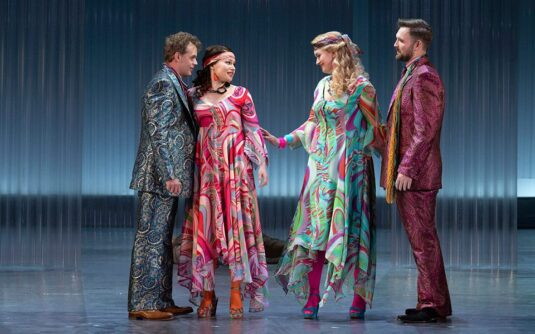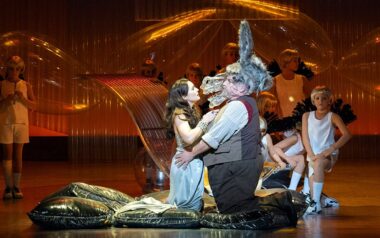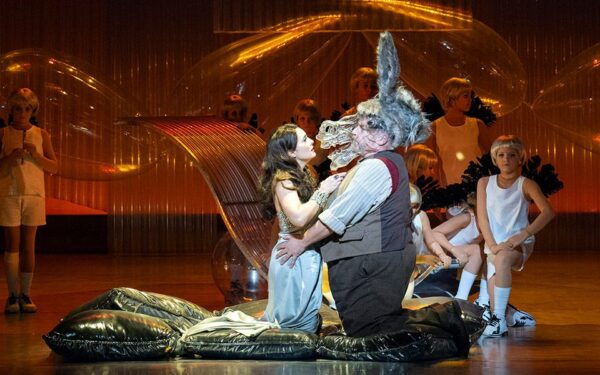 United Kingdom Opera North 2024 [1] – Britten, A Midsummer Night’s Dream: Soloists, Children’s Chorus, Orchestra of Opera North / Garry Walker (conductor). Lyric Theatre, The Lowry, The Quays, Salford, 13.11.2024. (MC)
United Kingdom Opera North 2024 [1] – Britten, A Midsummer Night’s Dream: Soloists, Children’s Chorus, Orchestra of Opera North / Garry Walker (conductor). Lyric Theatre, The Lowry, The Quays, Salford, 13.11.2024. (MC)

Martin Duncan’s production of Benjamin Britten’s fairytale opera A Midsummer Night’s Dream, first performed by Opera North in 2008 at Leeds, earned considerable praise. Not having seen Duncan’s staging before I was looking forward to this performance under revival director Matthew Eberhardt.
Based on William Shakespeare’s play of the same name the libretto of A Midsummer Night’s Dream is an adaptation of Shakespeare’s original text by Britten and Peter Pears who made considerable cuts, using just three of the five acts and added only a single line of their own. Premiered at the Jubilee Hall as part of the 1960 Aldeburgh Festival the next year it was taken up by Covent Garden in stagings directed by Sir John Gielgud.
In the main this is a magical opera, but only in parts, as its content is uneven and not without the longueurs that I found largely in the third act. It is admired by audiences despite its relative length and rather complex mix of numerous characters consisting of three groups: the Fairies, the Lovers and the Rustics. Martin Duncan’s production of A Midsummer Night’s Dream revived by Matthew Eberhardt stands up well and looks fresh. Britten wrote the opera in 1960, and the set is cleverly based a few years further forward in time to the so-called Swinging Sixties. An era associated with illegal drugs such LSD, amphetamines, barbiturates and cannabis is clearly linked to the libretti’s theme of magic flowers, as love potions.
Set on Midsummer Night, the forest abounds with all types of beings, there’s an assortment of strange noises, moonlight and shadows. The narrative concerns the chicanery of Oberon, king of the fairies, and his queen Tytania. Oberon gives Puck, a rascally sprite, the task of obtaining the sap of a magic flower that serves as a love potion. When sprinkled on sleeping eyelids it makes the individual fall in love with the first person they see. Oberon wishes Puck to sprinkle drops upon Tytania but by accident Puck puts the potion in Lysander’s eyes. Mischief and confusion ensue among the Lovers Lysander and Hermia, Demetrius and Helena.
Led by Quince and assisted by Bottom the band of six Rustics, are bungling amateurs rehearsing the play Pyramus and Thisbe that they hope will be performed at the forthcoming marriage of Theseus, Duke of Athens and to Hippolyta, Queen of the Amazons. For entertainment at the wedding, the Rustics get to perform the play.
Set designer Johan Engels eschewed the typical magical scene of the forest with its towering trees, heaving branches and rustling leaves, or lush wooded glades. Engles gave the audience a set constructed of translucent Perspex sheeting, both floor standing and hanging down. Positioned at the top of the stage were a cluster of large, clear plastic bubbles that floated high up between the Perspex. I cannot say my imagination was fired by Engels’s set, although it solved the practical problem of making the large stage area seem compact and acted as a barrier or walls.
Designed by Ashley Martin-Davies the costumes were most effective and fell generally into three groups. The Fairies King Oberon and Queen Tytania wore clothes consisting of silver panels of various sizes that immediately gave them an elevated presence. All evening the bright reflections from the silver panels glared fiercely into audience eyes. Dressed identically in white vest, t-shirt and socks, the fairy group of eighteen young boys and girls had rather creepy looking blonde wigs together with small black wings. Oberon’s sprite, Puck (Daniel Abelson) wore only a pair of red trunks, and his legs were covered in horrible thick hair.
Really standing out for style and colour were the psychedelic patterned outfits of the four young lovers, notably single-breasted suits and striped scarves for Demetrius (James Newby) and Lysander (Peter Kirk), and calf length dresses, coloured tights and headbands for Hermia (Siân Griffiths) and Helena (Camilla Harris). There was also the amusing occasion when the four appeared in acid bright underwear. Martin-Davies had decked out the merry band of Rustics in artisan workwear. During rehearsals and the performance of Pyramus and Thisbe the Rustics wore a variety of costumes relative to the character they are playing. At the time of Bottom’s dalliance with Tytania he was wearing an ass’s head and Tytania had changed into an alluring satin slip.

One had the sense that the principal cast members had been well rehearsed. All evening, I was impressed by the consistent quality of the solo singing especially the comedy numbers. Nevertheless, there were a few singers who stood out. Best of all was Henry Waddington as Bottom. In addition to his natural stage presence Waddington’s marvellous bass-baritone voice was both attractive and sonorous and projected clearly throughout the theatre. Especially enjoyable was the amusing scene when Bottom and Quince (Dean Robinson) were allocating roles for their play. Opera North has struck gold with Waddington, and I can easily recall his compelling Falstaff a year ago for the company. In the role of Oberon, James Laing was a clear and focused countertenor. With a range not as high as I usually encounter, Laing used his voice to impressive effect. Conspicuous for her sweet, high voice Daisy Brown gave a quite splendidly performance as Tytania. Congratulations are due to the eighteen boys and girls who made up the group of Fairies creating an enchanting sound that contributed efficaciously to the production.
Over the years Britten’s music has attracted some criticism. Of course it is not perfect, yet in the main I find the score highly effective, with some glorious passages and numerous solo contributions. I loved the way the music matched the three-character groups, such as low wind and brass for the Rustics. In addition, the top-drawer playing of the Orchestra of Opera North under Garry Walker added to the success of the overall production.
A superb night’s entertainment from Opera North, whose productions go from strength to strength.
Michael Cookson
Production:
Stage director – Martin Duncan
Revival director – Matthew Eberhardt
Set design – Johan Engels
Costume design – Ashley Martin-Davis
Lighting design – Bruno Poet
Revival lighting – Richard Moore
Choreography – Ben Wright
Cast:
Oberon – James Laing
Tytania – Daisy Brown
Puck – Daniel Abelson
Lysander – Peter Kirk
Demetrius – James Newby
Hermia – Siân Griffiths
Helena – Camilla Harris
Bottom – Henry Waddington
Quince – Dean Robinson
Flute – Nicholas Watts
Snug – Frazer Scott
Snout – Colin Judson
Starveling – Nicholas Butterfield
Hippolyta – Molly Barker
Theseus – Andri Björn Róbertsson
Peasbottom – Kitty Moore
Moth – Dougie Sadgrove
Mustardseed – Lucy Eatock
Cobweb – Jessie Thomas
